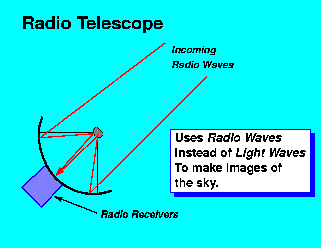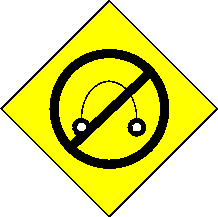This Frequently Asked Questions (FAQ for short) list attempts to answer questions about radio astronomy and the role the NRAO plays in it; a second FAQ that deals with more general information, such as questions about our tourist facilities, is also available.

You can read this screen because your eyes detect light. Light consists of electromagnetic waves. The different colors of light are electromagnetic waves of different lengths.
Visible light, however, covers only a small part of the range of wavelengths in which electromagnetic waves can be produced. Radio waves are electromagnetic waves of much greater wavelength than those of light.
For centuries, astronomers learned about the sky by studying the light coming from astronomical objects, first by simply looking at the objects, and later by making photographs. Many astronomical objects emit radio waves, but that fact wasn't discovered until 1932. Since then, astronomers have developed sophisticated systems that allow them to make pictures from the radio waves emitted by astronomical objects.
A number of celestial objects emit more strongly at radio wavelengths than at those of light, so radio astronomy has produced many surprises in the last half-century. By studying the sky with both radio and optical telescopes, astronomers can gain much more complete understanding of the processes at work in the universe.
What are you listening to?Actually, nothing! While everyday experience and Hollywood movies make people think of sounds when they see the words "radio telescope," radio astronomers do not actually listen to noises.

First, sound and radio waves are different phenomena. Sound consists of pressure variations in matter, such as air or water. Sound will not travel through a vacuum. Radio waves, like visible light, infrared, ultraviolet, X-rays and gamma rays, are electromagnetic waves that do travel through a vacuum. When you turn on a radio you hear sounds because the transmitter at the radio station has changed the characteristics of the radio waves to make them carry information about the sound of voices and music. Your radio receives the radio waves, decodes this information and changes it back into audible sounds.
The VLA and the VLBA are designed to produce images of celestial bodies. Just as photographic film records the different amount of light coming from different parts of the scene viewed by a camera's lens, our radio telescope systems record the different amounts of radio emission coming from the area of the sky we observe. After computer processing of this information, astronomers can make a picture.
No scientific knowledge would be gained by converting the radio waves received by our radio telescopes into audible sound. If one were to do this, the sound would be "white noise," random hiss such as that you hear when you tune your FM radio between stations.
What have you discovered lately?A lot! For some of the highlights, look at NRAO's press releases about recent research results. Every year, hundreds of scientists use NRAO's radio telescopes, and they report their results in numerous papers in scientific journals. Almost any introductory astronomy textbook will contain images and tell of research results from NRAO's various radio telescopes.
Is NRAO doing SETI work?Radio observations as part of a Search for Extraterrestrial Intelligence (SETI) have been done by different groups of researchers for a number of years, but this type of work is not a part of NRAO observational programs. For the most part, our radio telescopes have been designed and built for other astronomical purposes. For example, the VLA and the VLBA are specifically designed for high-resolution imaging. At the moment, the SETI Institute, a privately-funded organization, is purchasing observing time on the 140-foot radio telescope in Green Bank, which NRAO is retiring from other research in anticipation of the new Green Bank Telescope coming on-line.
Can I build a radio telescope at home?Many electronic experimenters have built their own radio telescopes. In fact, the world's second radio telescope was built by an amateur radio operator, Grote Reber, in 1937. Amateurs use a variety of equipment, sometimes modified satellite receivers and dishes, to build their radio telescopes. For more detailed information about amateur radio telescopes, contact the Society of Amateur Radio Astronomers.
Amateur radio operators pursue a number of activities that are somewhat related to radio astronomy, including communicating by bouncing radio signals off the Moon and the ionized trails of meteors in the Earth's atmosphere. There also are a number of amateur radio satellites in orbit. Both the Space Shuttle and the Mir space station carry amateur radio equipment that frequently is used by the astronauts to communicate to "ham" operators and classrooms around the world. For general information about amateur radio, including how to obtain your own license, contact the American Radio Relay League.
I think I'd like to become an astronomer. What training do I need?The typical training for a research astronomer includes earning a Bachelor's degree in Physics, Astronomy or Mathematics, followed by graduate school and a Ph.D. in Astronomy or Astrophysics. The American Astronomical Society, the professional association for astronomers in North America, offers a free brochure on careers in astronomy. High school students interested in astronomy should take as many courses in science and mathematics as possible in preparation for college.
Where can I find more information about astronomy?The World Wide Web is a gold mine of information on astronomy and space science. This includes everything from on-line astronomy courses to archives of thousands of astronomical images. An excellent starting point is the AstroWeb site.
Other sources of astronomical information include your public or school library and monthly magazines such as Sky & Telescope and Astronomy. There may be an amateur astronomy club in your community, and if there is, it is a good place to meet others who are interested in astronomy and to join activities such as observing with telescopes and hearing lectures on astronomical topics. Your community also may have a planetarium, public observatory or science museum that can provide information. The Web sites of the two magazines listed above have listings of clubs, observatories, planetaria and astronomical events for communities throughout the United States.
Can I get images or data from NRAO's radio telescopes?Yes, you can find these on the NRAO Image Gallery. In addition, images and data from two surveys of the sky made by the VLA are available on the Internet. You also may download software for viewing these image files. Check out the NRAO VLA Sky Survey and the FIRST Survey Web pages.
[an error occurred while processing this directive] Modified on Friday, 26-Sep-2008 13:48:36 EDT [an error occurred while processing this directive]